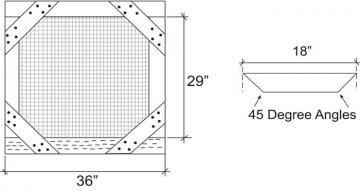
Compost Bin Design

A wood and wire cage-type composting bin can be constructed in about two hours. The benefits of this type of composting bin are its simplicity to build, low cost and ease of turning compost because of removable side panels. Also, the bin is portable and its wire screening allows for good air circulation. The cost of the bin varies depending on the source of materials.
| List of Materials | List of Tools | |
|---|---|---|
| 1 | 2” x 4” x 12’ rot resistant material such as cedar, redwood, plastic lumber or Chromated Cooper Arsenate (CCA) pressure treated wood | Hammer |
| Saw | ||
| Wire cutters | ||
| 3 | 2” x 4” x 12’ construction grade | Industrial-type stapler with ½” staples |
|
2 |
36” x 12’ length of 3 hardware cloth (screen) | Screwdriver (if screws are used) |
| 128 | 12d galvanized nails or 13” screws | |
| 8 | 3” hook-and-eye latches | |
Construction Details
- Cut the 12’ rot resistant 2” x 4” into four 36” pieces.
- Cut one of the 12’ construction grade 2” x 4” into four 36” pieces.
- Cut the two remaining 12’ construction grade 2” x 4” into eight 29” pieces.
- Cut the two 12’ one by fours into sixteen 18” pieces.
- Cut a 45 degree angle on each end of the 18” pieces of the 1” x 4” (see diagram).
- Make four 36” square frames from two 36 inch pieces of 2” x 4” and two 29” pieces of 2” x 4”.
- Use one rot resistant 2” x 4” on the bottom of each frame.
- Lay one 18” piece of 1” x 4” at each corner of a frame and secure with 12d nails or 13 “ galvanized screws.
Rot Resistant Lumber on Bottom
- Cut the screen with wire cutters into four 36” sections. Lay one piece on each frame directly on the 2” x 4”. Tack each section of hardware cloth to a frame with ½” staples. Keep screen
as tight as possible. - Each resulting wood and wire panel frame should have a rot resistant piece on the bottom. Connect each frame to another frame with hook-and-eye latches.
- While several studies have shown a minimal risk associated with the use of CCA pressure treated lumber in direct contact with organic compost, alternative rot resistant materials such as cedar, redwood or plastic lumber may be used in the ground-contact portion of the composting bin.

